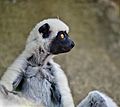Off-the-ceiling Sifaka
| Off-the-ceiling Sifaka | ||||||||||||
|---|---|---|---|---|---|---|---|---|---|---|---|---|

Off-the-ceiling sifaka ( Propithecus ceilingii ) |
||||||||||||
| Systematics | ||||||||||||
|
||||||||||||
| Scientific name | ||||||||||||
| Propithecus ceilingii | ||||||||||||
| A. Grandidier , 1867 |
The Von-der -cken-Sifaka ( Propithecusckenii ) is a primate species from the family of the Indri-like within the lemurs . It was formerly considered a subspecies of the larval sifaka .
features
The fur of the Von-der-Ceiling Sifakas is predominantly white, the neck, shoulders, back and limbs are sometimes light yellow-brown or silver-gray in color. The skin color is black. The face and the small round auricles are hairless, the snout is more blunt than that of other Sifakas . The eye color is red or orange-red. There are also melanistic individuals, in which the head and neck are black and the shoulders, upper arms and the front part of the back are gray-brown. These animals reach a head body length of 42 to 48 centimeters, the tail measures 50 to 60 centimeters and the weight is 3.5 to 4.5 kilograms.
Distribution and way of life
Like all lemurs, off-the-ceiling sifakas only live in Madagascar . Its distribution area is on the west coast of the island between the Mahavavy and Manambolo rivers, but the exact boundaries are not known. Their habitat are dry deciduous forests. Otherwise, little is known about their way of life, which should largely correspond to that of the larval sifaka. They are diurnal and mostly stay in the trees. They live in groups of two to ten (usually three to six) animals.
Danger
The main danger for these primates is the destruction of their habitat through deforestation and charcoal production. Due to a strict taboo , they are not hunted in a large part of the range, they become relatively tame and also live in localities. The IUCN lists the species as "endangered" ( vulnerable ).
literature
- Nick Garbutt: Mammals of Madagascar. A Complete Guide. Yale University Press, New Haven CT 2007, ISBN 978-0-300-12550-4 .
- Thomas Geissmann : Comparative Primatology. Springer-Verlag, Berlin et al. 2002, ISBN 3-540-43645-6 .
- Russell A. Mittermeier , Jörg U. Ganzhorn, William R. Konstant, Kenneth Glander, Ian Tattersall , Colin P. Groves , Anthony B. Rylands, Andreas Hapke, Jonah Ratsimbazafy, Mireya I. Mayor, Edward Louis jr, Yves Rumpler, Christoph Schwitzer, Rodin Rasoloarison: Lemur Diversity in Madagascar. In: International Journal of Primatology. 29, 2008, ISSN 0164-0291 , pp. 1607-1656.
- Neil Shea: Stone Forest (Tsingy de Bemaraha, Madagascar's limestone forest). In: National Geographic. 11/2009, online .
Web links
- Propithecus deckenii in the Red List of Threatened Species of IUCN . Retrieved April 26, 2009.
- National Geographic photo gallery: Stone Forest - Tsingy of Madagascar




